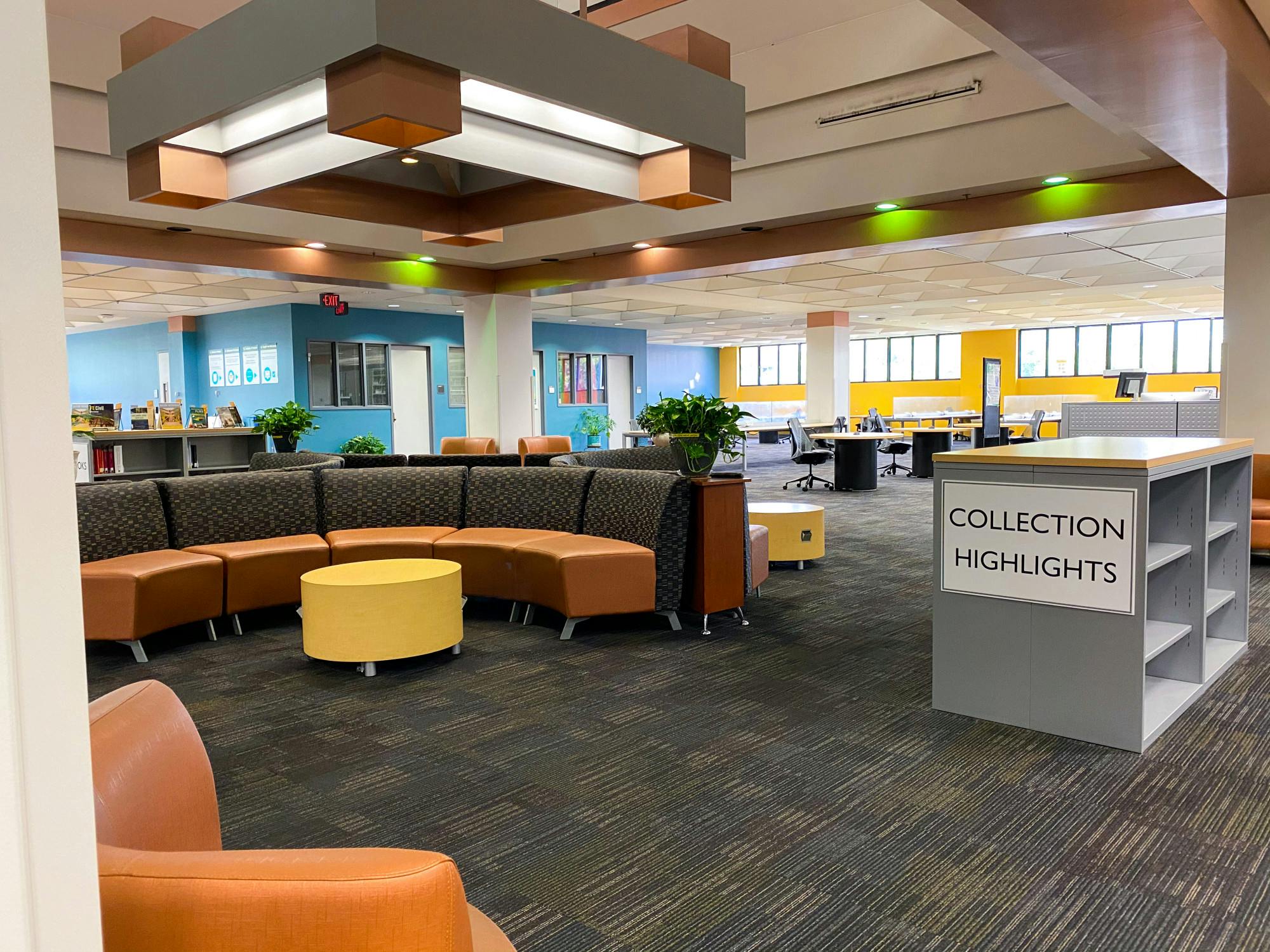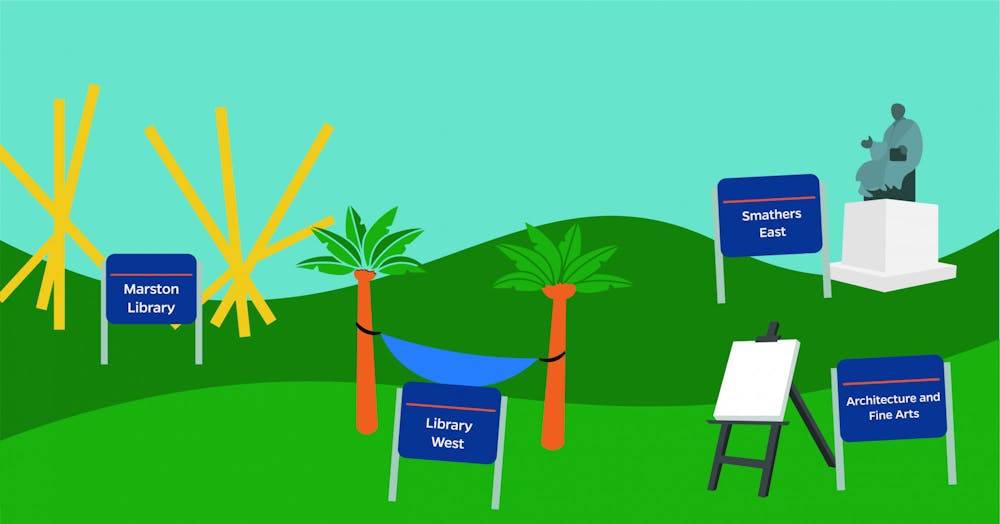During a typical year at UF, the bustle of campus life is hard to miss — with students racing to class, hurrying to catch a bus, or weaving their way through Plaza of the Americas to grab Krishna lunch. Amid the flurry of students, the six George A. Smathers libraries provide an escape for both students and faculty alike to seek refuge.
“There are times when there's just too many distractions in your living environment,” University Libraries dean Judith Russell said. “We think the libraries are a place that give the students [another] option. And there's so many options, many different locations, different libraries with different characteristics.”
Consisting of six different libraries — Architecture and Fine Arts Library, Education Library, Health Science Center Libraries, Library West, Marston Science Library and Smathers Library — The George A. Smathers libraries form the largest information resource system in Florida. The Levin College of Law’s Legal Information Center also holds a collaborative relationship with Smathers libraries.
Library visitors have access to a growing collection of 6.17 million print volumes, in addition to more than 62,000 UF dissertations and theses. If guests don’t have time to visit one of the six libraries, they can access 1.5 million e-books and over 14 million digitized pages by navigating the Smathers libraries’ website.
Like all other areas on campus during the COVID-19 pandemic, the Smathers’ libraries were forced to drastically adjust their procedures. To ensure safety within the libraries — which collectively attract 4.5 million visitors annually — seating capacities were reduced, face coverings were required and Gator 1 ID cards were mandatory upon entry to check if students were cleared for campus.
“I was dreading the idea that people would show up and want to come into the library, and we'd have to say there's no room,” Russell said.
Services such as Ask-A Librarian — a free library service that allows students to seek assistance from library staff through email, text, or instant message — flourished during the pandemic when many students found themselves no longer on campus. Now, as campus facilities will open at full capacity during Summer B and masks are now optional, the six branches of the Smathers libraries look to fully resume their unique services to their patrons.
Library West

After whirling through the revolving entrance doors and grabbing coffee from Starbucks, patrons of Library West hurry up the escalator to find a peaceful seat to study. Serving as the centerpiece of Plaza of the Americas, Library West remains one of the most popular libraries on campus.
With seating for approximately 1,400 visitors and an official “quiet study” space on the fourth floor, Library West is designed to withstand the rush of students who may flood the building during final exams week. Students can choose to sit at the various tables, chairs, study rooms, or FitDesk study bikes located throughout the building.
Designated as the humanities and social sciences library, students have access to collections from various fields: books, microform materials, newspapers, periodicals, journals and DVDs.
In addition to the 18 group study rooms at Library West, students can use unique spaces like the One Button Video Recording Studio — a recording studio equipped with HD cameras, lighting, audio equipment and a green screen function. Another space in Library West, the Accessibility Studio, is available for registered Disability Resource Center students to have a private space to interact with library resources.
The library staff aims to make Library West a more inclusive space for visitors of all backgrounds, according to Library West chair Stacey Ewing. Like other library branches, a lactation room and gender-neutral bathrooms were added in Library West. As a way to further accommodate students during the pandemic, Library West added 10 test proctoring booths for students who did not have a quiet area at home to take an exam.
Library East (Smathers)

At first glance, Library East appears to be a modest building, as it blends in with the surrounding lecture halls. However, one step inside reveals that the library is filled to the brim with historical treasures.
Dating back to 1925, Library East is the oldest library on campus with an original capacity of 800. In nearly 100 years, Library East’s four floors have become home to remarkable collections, including the Map and Imagery Library, Isser and Rae Price Library of Judaica, and the Latin American and Caribbean Collections.
Located on the first floor, the Map & Imagery Library is one of the largest academic map libraries in the country, containing around 500,000 maps, 300,000 aerial photographs and 8,000 reference books and atlases.
On the second floor, students can enter the Grand Reading room to be assigned a table to access non-circulating materials. The Judaica Suite, attached to the Grand Reading Room, is filled with rare books from the Isser and Rae Price Library of Judaica. In addition to the priceless books found in the Judaica Suite, students can observe the handmade artwork of Kenneth Treister, the architect of the room.
One of Library East’s most distinguished collections, the Latin American and Caribbean Collection, was founded in 1951 and is currently located on the third floor of Library East. The collection contains around 500,000 volumes in English, Spanish, Portuguese, and various indigenous languages. The collection also serves as a way for many Latinx students to connect with their culture, LACC public services associate Keith Manuel said.
Although the COVID-19 pandemic reduced Library East’s capacity and hours, it provided a unique advantage: increasing and improving its digital collections. As fewer students were able to access physical prints of literature, library staff were tasked with scanning and photographing the collections so students could find what they needed online.
Marston Science Library

Sitting right beside the Hub and Turlington Plaza, Marston Science Library sits in a convenient spot on campus and garners a substantial amount of foot traffic. With the yellow gangling Alachua sculpture — lovingly known as the French fries — located right outside the building, Marston is hard to miss.
Named after the seventh UF president Robert Q. Marston, Marston Science Library caters to the university’s scientific community. The library was built in 1987 to consolidate the six original UF science branch libraries: Agriculture, Physics, Botany, Engineering, Chemistry and Biology-Geology.
Students can choose which of the five floors best fit their studying needs, with the bottom three floors being designated for group study and the top two floors for quiet study.
Marston Science Library remains a technological pioneer among the other Smathers libraries. In addition to maintaining five computer labs within the building — with one of them specialized for augmented reality development — Marston offers a multi-purpose visualization and conference room for students to reserve for meetings, Marston Science Library chair Valrie Minson said.
Not only does Marston offer an abundance of technology, but their expanding tool library allows students to loan out take-home equipment ranging from drill sets to sewing machines.
Architecture and Fine Arts Library
With a growing collection of 125,000 volumes, the academic needs of students from both the College of Design, Construction & Planning and the College of the Arts are satisfied by the Architecture and Fine Arts Library. Since its opening in 1965, the AFA library has emerged as one of the largest art library collections in the southeastern United States.
Unlike its neighbor Marston Science Library, the AFA library discourages extended group study sessions due to the vast open space of the library. Instead, individual study is enhanced through the use of the famous double-decker carrel units equipped with electrical outlets, which are found throughout the reading room.
Through the AFA library, comprehensive research guides were also created for students pursuing different disciplines supported by the library. The guides include a variety of topics within the arts and architecture professions including ceramics, dance, construction management, interior design and sustainability.
Education Library

The UF Education Library's circulation desk after the renovation
Opened in 1980, the Education Library is home to over 80,000 textbooks, children’s and young adult books, and journals. Right outside its doors, a beloved oak tree — winner of the 2021 UF Library Landmark Lollapalooza — stands tall to be admired by the library staff and students alike.
Separated from the main campus by Norman Field, the Education Library remains hidden from a large part of the UF population. However, its proximity to Sorority Row and other off-campus housing makes it a prime spot for some students to resume their studies close to home, Rachael Elrod, head of the Education Library, said.
Although the library supplies print materials meant to support programs within the College of Education, the expansion of educational technology is on the rise within the Education Library — specifically within the EduGator Makery.
The EduGator Makery is a space within the Education Library that holds traditional educational technologies such as die cuts, a laminator and video editing software.
To Elrod, the Education Library offers an alternative for students who want to get away from the fast pace of UF’s campus.
“I think there's just this feeling of community,” Elrod said. “It tends to be a very quiet library as opposed to Library West or Marston where there's lots of activity...there’s nothing wrong with that, but people seeking out a quiet environment in the library would really find a home here.”
Health Science Center Libraries

Unlike the other library branches, the Health Science Center Libraries have two locations: Gainesville and Jacksonville.
The Borland Health Sciences Library seeks to support patrons at UF Health in Jacksonville by providing health resources and research to doctors.
The main Health Science Center library in Gainesville serves over 11,000 students, faculty and staff from the six Health Science Center UF colleges. HSC libraries also serve Shands Health Care by supporting its clinical and research missions through its exceptional health collections.
The HSC library played a critical role in community mitigation of COVID-19 through the creation of a COVID-19 library guide with resources for healthcare practitioners and the public, according to nursing and consumer health liaison Maggie Ansell. The library guide was helpful to many members of the local community who were unsure of how to navigate the emerging COVID-19 health information.
Improving mental health is another mission of the HSC library — whether it be through providing jigsaw puzzles and coloring kits for students to distract themselves, offering nap pods for students to relax in, or inviting local therapy dogs throughout the semester.
Two local therapy dogs, Beau and Lentil Bean, as well as their owners Terry Biehl and Elizabeth Pearlman, are frequent visitors to the HSC library, stopping by a couple times a semester to greet students.
“[Beau] loves visiting students, I would have to say of all the therapy work, it's his favorite,” Biehl said.
In order to abide by CDC guidelines, Beau and Lentil Bean’s visits were moved outside of the HSC library. Guests were instructed to maintain social distancing, wear masks, and wash their hands before and after petting the dogs.
The student debate: which library is the best?
Although each of the six branches collaborate with one another to put on Smathers library-wide events like the annual fall festival, they also enjoy participating in healthy competition — mostly brought about by UF students who have pledged their allegiance to one of the libraries.
Choosing a favorite UF library can be determined by numerous factors: location, the collections offered, seating arrangements, or even the presence of a Starbucks inside. For Gabby Whitler, 21-year-old psychology senior, the ornate aesthetics of Library East secured its location as her regular study spot.
“The ambience of [Library East] is just really nice and helps me focus,” Whitler said. “It almost helps me fantasize [that] I enjoy studying and manifest that mindset.”
Other students like 20-year-old accounting junior Kate Ross found comfort in studying at Library West, even if it meant taking a detour from her normal path on campus.
“Overall, I find the furniture and overall appearance in library west to be very appealing both to sit in and look at,” Ross said. “Library West is further than a lot of the dorms on campus, but it is definitely worth the extra walk.”
Melanie Halem, a 20-year-old political science and mathematics senior, said Marston’s top floors are the perfect place to focus on schoolwork.
“I think the fifth floor cubbies are just perfect,” Halem said. “There's a cubby with plants around it that is so beautiful. It has such a great view of Beaty Towers too.”
Haley Geer, 20-year-old animal science junior, also identified Marston as her favorite library at UF, as she felt that the library contained various collections and equipment that catered to her field of study.
“It works really well for STEM students, which I know is the purpose of it, but I always found it very accessible,” Geer said.
For Craft Talbot, a 21-year-old business management senior, Marston Science Library is more than just a favorite study spot. In February, Talbot adopted a bunny from Gainesville Rabbit Rescue and named him after her favorite spot on campus — Marston.
“I can't wait [for] my senior year,” Talbot said. “I'm definitely going to take graduation pictures in front of [Marston Science Library] with Marston.”
Contact Makiya Seminera at mseminera@alligator.org. Follow her on Twitter @makseminera.

Makiya Seminera is a UF international studies and Arabic senior, with a minor in mass communication. She's currently the editor-in-chief of The Alligator, but has previously served as university administration reporter, The Avenue editor, social media manager and opinion editor. She also serves as managing editor for Florida Political Review. Over summer, she interned with The State in Columbia, South Carolina, as a politics & government reporting intern.






